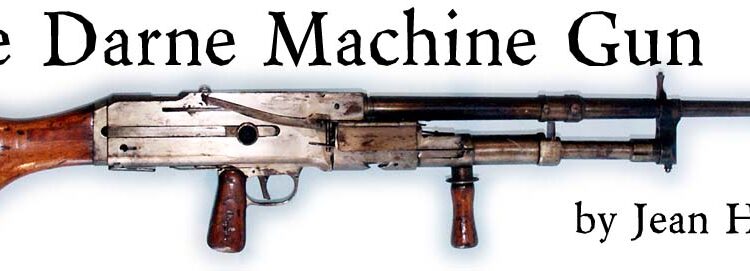 . THE DARNE MACHINE GUN
. THE DARNE MACHINE GUN
By Jean Huon
A relatively unknown machine gun used by France and other countries from WW I to the 1930s, was developed by Régis Darne and his son Pierre in 1916. The Darne Company, created in 1881, was a famous small arms manufacturer in Saint-Etienne and was well known by its famous fixed barrel shotgun, with straight pull bolt locked by a moving lever.
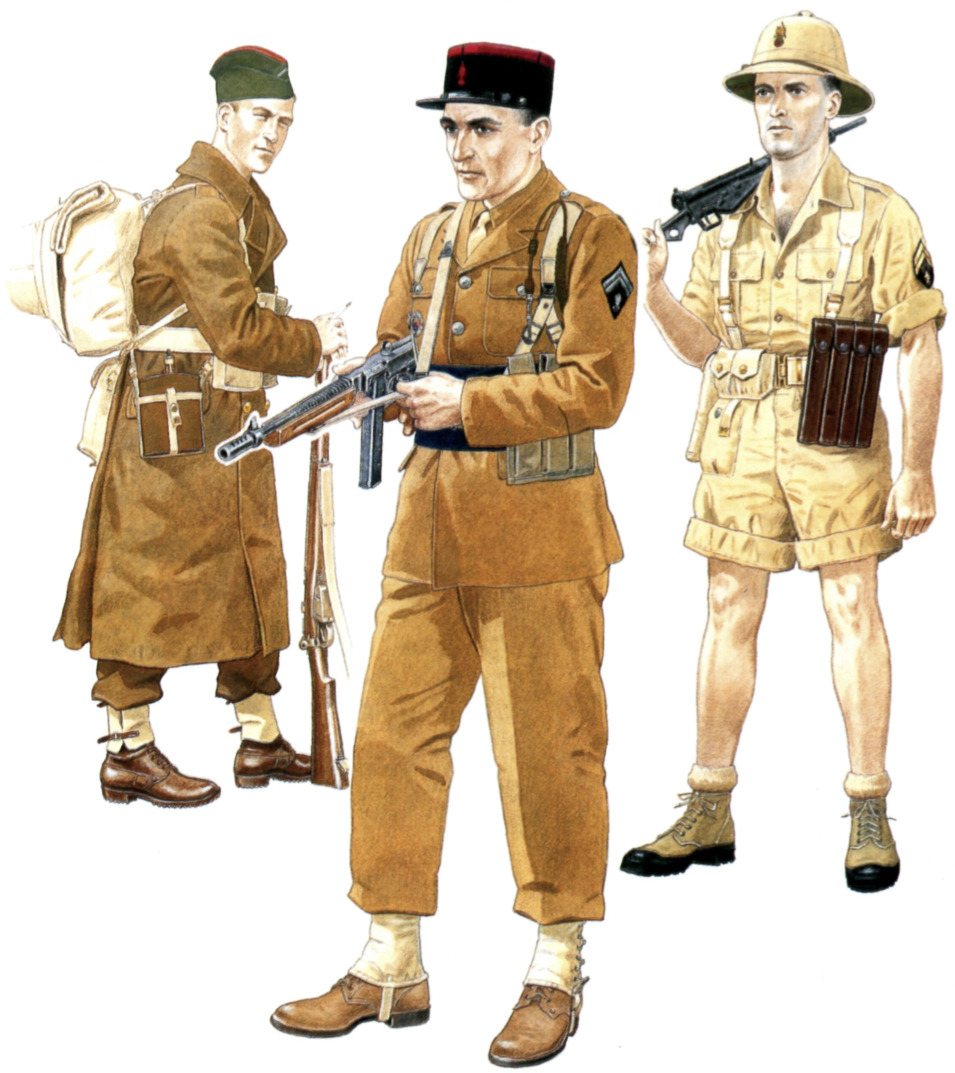
In 1915, the Darne Company obtained a license to produce Lewis machine guns for aircraft. In the beginning it produced five guns per day but its production capacity increased and at the end of World War I, the Maison Le Fusil Darne had produced 3,266 Lewis aircraft machine-guns. One thousand weapons of the same type were produced by the Mildé factory in Paris, a company specializing in the manufacture of mechanical and electrical components for cars.
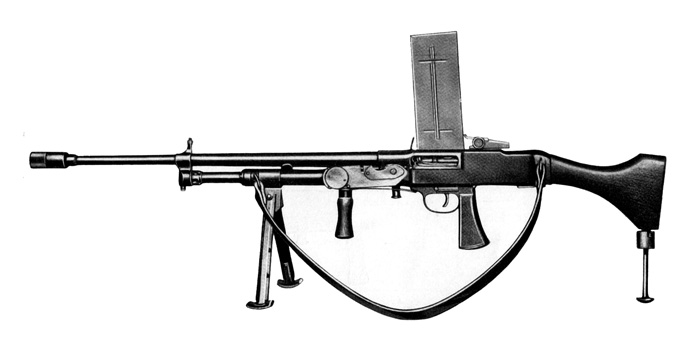
Darne automatic rifle. (Authorís files)
In 1916, Régis and Pierre Darne developed a new machine-gun. Some specimens were delivered to the French Army in 1917; and in August 1918, the Darne Company received a large order for machine guns for infantry and aircraft for military operations in the next year (spring 1919). Because of the armistice on November 11, 1918 the order was cancelled but the Darne company was invited to continue the development of machine guns and improve them.
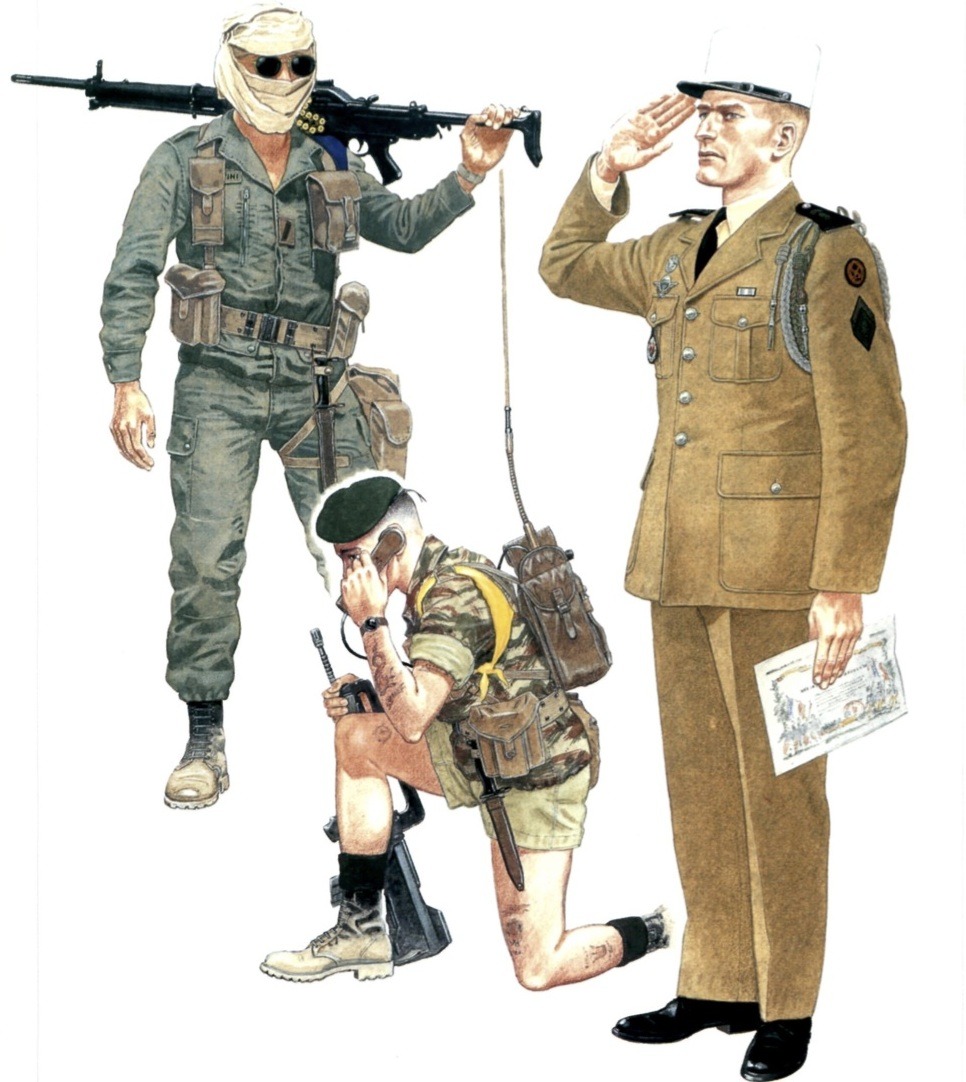
The guns were developed with the assistance of the French Army engineering services for artillery and aircraft. But the managers of the Darne Company took a larger view. They organized a Military Division which was able, with the help of the Hunting Division, to manufacture 1,500 machine guns per month.
Then they developed a true weapons system using a single mechanism, cooled by air, which could be adapted to the use of any ammunition from 6 to 8 mm cartridges, rimmed or rimless.

Left side of the Darne light machine gun. (Jean Huon)
- Automatic rifle with 20-, 25- or 30-round magazine. At the choice of the customer, the weapon could be provided with a selector allowing delivery of two or three rates of fire: from 100 shots per minute with a regulator, up to 800 shots per minute for anti-aircraft defence. Equipped with a stock and a monopod, it weighed only 15.2 lbs (6.900 kg).
- Light machine gun, with large volume of fire, fed by 150 or 250 cartridge belt. Variable cyclic rate with two or three rates, from 150 up to 1,000 rounds per minute. Weight is 20 lbs (9 kg), or 21.4 lbs (9,700 kg) with stock and 28.7 lbs (13 kg) with a light tripod.
- General Purpose Machine gun, same as above, but whose weight is from 33 to 55 lbs (15 to 25 kg) according to the models.
- Tank machine gun.
- Aircraft machine gun synchronized for shooting through the propeller, with a rate of fire from 1,000 to 1,350 rpm. Weight 18.2 lbs (8,250 kg).
- Wing or turret aircraft machine gun. Weight is 17.2 lbs (7.8 kg).

The manufacturer also proposed a “big bore” machine gun (11 to 15 mm), able to be furnished in normal or synchronized version. The rate of fire was approximately 900 rounds per minute. Weight 22 to 33 lbs (10 to 15 kg).
From 1918 to the mid-1930s, the Darne company manufactured approximately 11,000 machine guns sold to the following countries: Brazil (150), Spain (1,200), France (approx. 6,000), Italy (1,000), Lithuania, Serbia (2,500) and Czechoslovakia.

Darne aircraft machine-gun M1926, synchronized for shooting through the propeller. (Jean Huon)
In 1922, France adopted the Darne aircraft machine gun for turrets in .303 caliber using a fabric belt.
In 1933, a new 7.5mm aircraft machine gun entered service that was able to be used in the turrets, wings or nose of airplanes. Cartridges were carried on a metallic detachable link belt (the state small arms factories would only be able to do this in 1939 by using the Darne links).
This weapon was used on several Air Force and Navy planes, including:

- Potez 452 patrol seaplane, 1 machine gun in the top turret,
- Latécoère 290 torpedo seaplane,1 machine gun in the top turret,
- Latécoère 299 light bomber, 2 machine guns in the wings, 1 in the top turret,
- Latécoère 523 transport seaplane, 4 machine guns on the sides and another in the top turret,
- Breguet 521 transport seaplane, 4 side machine-guns and 1 in the tail turret,
- Bloch 210 or 211 bombers, 3 machine guns in turrets.
- Potez 54 bomber, 2 turrets with one a machine gun in each,
- Lioré et Olivier H 43 observation seaplane, 1 machine gun in wing and 1 machine gun in turret.

According to the type of feed block, the belt can be fed from the right or left, for wing and nose mounted machine guns.
After 1940, the Germans kept Darne machine guns in service and gave them the code number leMG 106 (f). Some of them would have been used for fixed defence in Normandy and the Channel Islands.

Darne aircraft machine-gun M1926. (Jean Huon)
Description
The receiver contains the bolt and feeding system and has flat sides. The gas cylinder is connected to a collar and locks an adjustment valve. Operation in different circumstances is ensured by a large gas hole, which lessens the risk of failure but gives a very high rate of fire. The return spring is located in the centre of the piston. The plunger and bolt are a common part; it receives a mobile head that locks after tilting. Its rear part moves up and locks on the upper part of the frame. Displacement of the head is ensured by an oblique slope. The striker is fixed on the bolt head.
Feed is ensured by a fabric or metal link belt, except for the automatic rifle which uses a box magazine. The movement of the belt is made by a shuttle moving transversely. The shuttle is moved by a system of rods connected to a link, operated by two lobes of the feed cam in the feed box. One pawl advances the cartridge in the belt; while the other prevents it from moving back. Cartridge feed is obtained by a conveyer provided with two elastic arms. It extracts the cartridge from the link, brings it back while a curved lever pushes it upwards to place it on position to be chambered. Cyclic rate on the infantry guns is moderated by a device fitted on the feeding mechanism. High cyclic rate on aircraft guns is obtained with an accelerator, which increases the forward speed of the bolt.
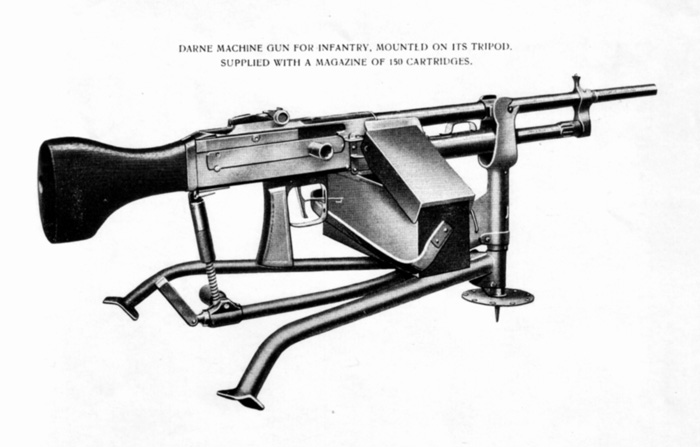
General purpose machine gun on tripod (right side). (Authorís files)
Operation
The Darne machine gun works by gas pressure, with the bolt attached to the sear and a cartridge being held by the conveyer ready to be chambered. When the trigger is pressed, the sear goes down, and the bolt unit moves forward pushed by the return spring. The cartridge is pushed to the chamber and the bolt closes and locks. The next cartridge of the link is held by the conveyer. When the bullet passes the gas port, a part of the gas goes into the cylinder and pushes the piston unit backwards. The bolt is unlocked and opened and the empty case is extracted and ejected. The piston unit moves back, while the cam of the feeding mechanism moves the belt placing a new round in position. The preceding cartridge goes to the rear. At the end of the movement the curved lever moves the cartridge tip up, ready to be chambered.

Always ensure that the belt has been removed and the chamber is clear. Remove the back cover plate, after having pushed back the recoil spring rod. Extract the recoil spring, the piston unit and the feeding mechanism. Current servicing does not require the disassembly of other parts. Reassembly is carried out in the inverse order.
Often criticized wrongly because of their rusticity, the Darne machine guns were simple, crude and cheap. They had qualities that many contemporary weapons could envy. In 1931, a Darne machine gun was sold for 700 Francs (approx $480 in 2012 dollars), which was the price of an ordinary shotgun at this time. The number of parts was reduced to the minimum and manufacture calls upon a maximum of manufactured goods (tubes, rods, laminated rods).
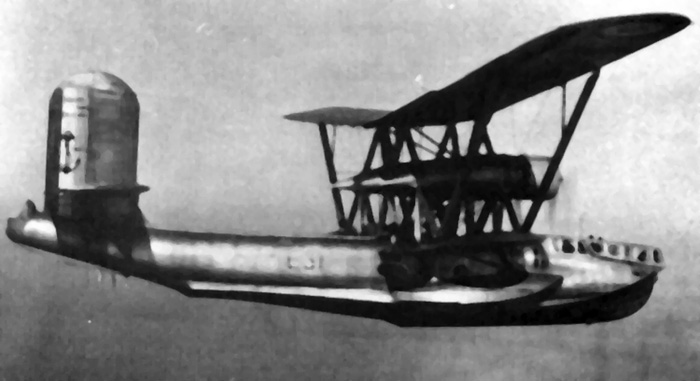
Transport seaplane Breguet 521 receives 5 Darne machine guns: 2 on each side and an other one in the tail turret.

They were also very reliable. A test carried out in 1932, at 25.000 feet of altitude in -18° Celsius temperatures showed that they worked perfectly even in great cold. Why were they then not more successful? Probably because the Army authorities did not appreciate that a small private factory could make better guns than State factories. The MAC 34 aircraft machine gun developed by Chatellerault was made to avoid the choice of the Darne machine gun. But it has an incredible feeding device used for wing machine gun consisting of a 300 round cylindrical drum with feed mechanism.

Well before the MAC 34-39 wing gun, the Darne functioned with detachable metallic links. In 1922, the manufacturer proposed a model synchronized to fire through a four bladed propeller while the Manufacture d’Armes de Chatellerault did not start the development of an equivalent model until 1939 and it was not completed before the end of the hostilities.
Also the tilting bolt of the Darne machine gun was used on the MAS 1928 experimental semiautomatic rifle. This device was retained for the MAS 44, MAS 49 and MAS 49-56 rifles.
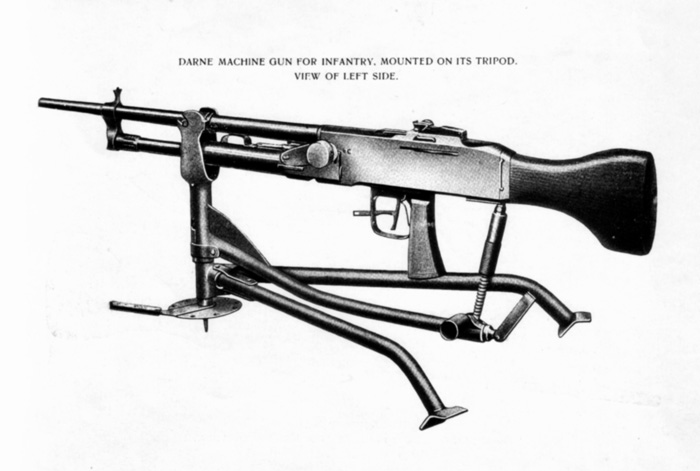
General purpose machine gun on tripod (left side). (Authorís files)

Darne M1933 aircraft machine gun for turret. (Jean Huon)
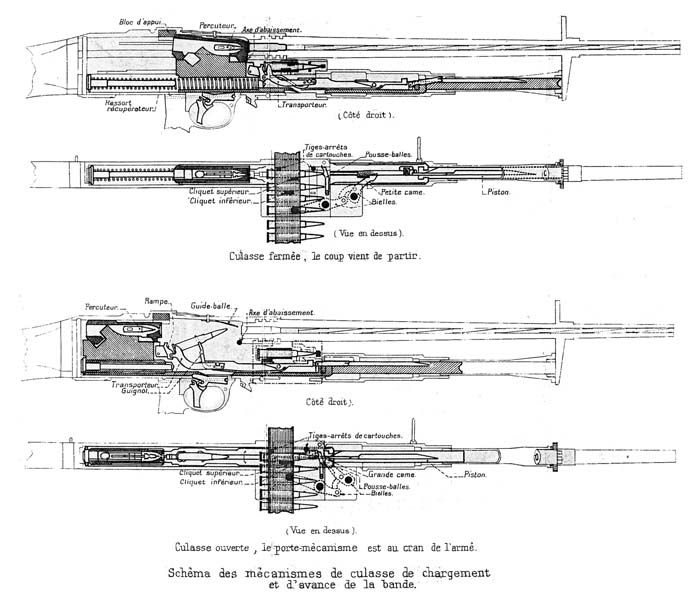
Sectional view of Darne machine-gun. (French Navy)
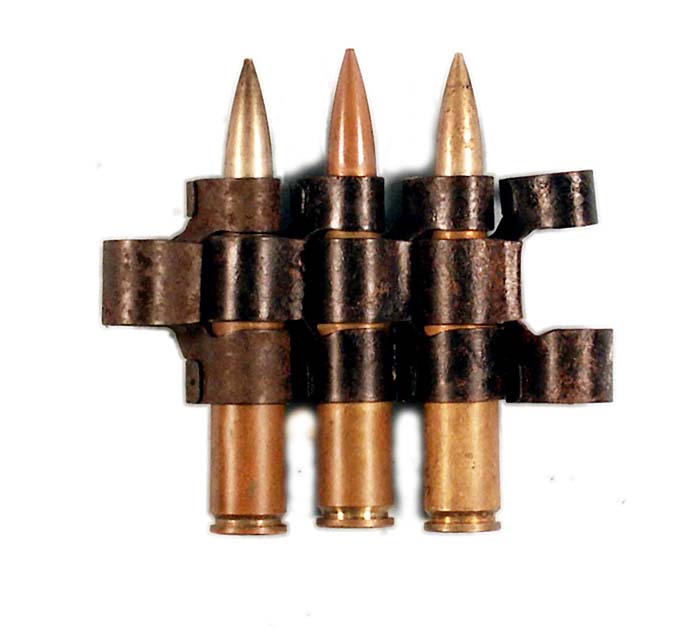
7.5mm cartridges on Darne links. (Jean Huon)
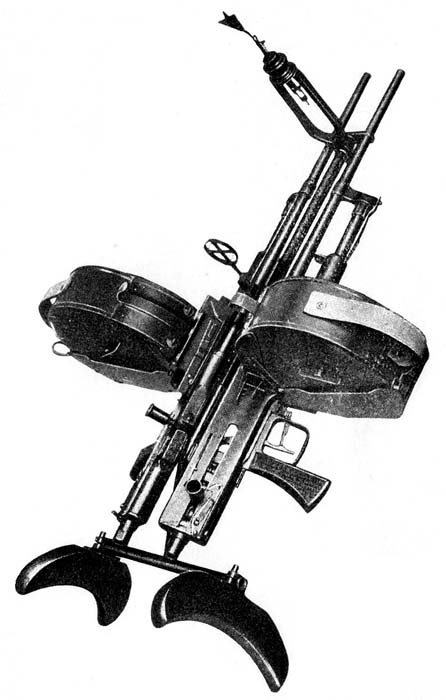
Twin mount of Darne machineguns in turret. (Authorís files)y  yy
yy
